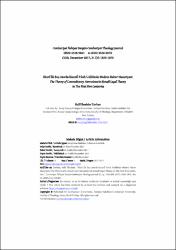| dc.contributor.author | Turhan, Halil İbrahim | |
| dc.date.accessioned | 2020-12-19T20:30:40Z | |
| dc.date.available | 2020-12-19T20:30:40Z | |
| dc.date.issued | 2017 | |
| dc.identifier.citation | Turhan, H.İ. (2017). Hicrî İlk Beş Asırda Hanefî Fıkıh Usûlünde Muârız Haber Nazariyesi. Cumhuriyet İlahiyat Dergisi, 21(3), 1825-1872. https://doi.org/10.18505/cuid.344405 | en_US |
| dc.identifier.issn | 2528-9861 | |
| dc.identifier.issn | 2528-987X | |
| dc.identifier.uri | https://app.trdizin.gov.tr/makale/TWpjME16QXhNUT09 | |
| dc.identifier.uri | https://hdl.handle.net/11436/5448 | |
| dc.description.abstract | Fıkıh mezhepleri haberler arasında çelişkilerin giderilmesinde farklı metotlar uygulamışlardır. Esasında bu yöntem farklılığı da doğrudan bir meselede farklı görüş beyan etmeyi, yani, fıkhî ihtilafı da beraberinde getirmiştir. Dolayısıyla bir ekol, muârız haberlerin değerlendirilmesinde izlediği yöntemle ilgili yaptığı izahlarla, ulaştığı fıkhî hükümde muârız haberlerden hangisini delil olarak kullandığını ve bu haberle ihticâc gerekçesini, konuyla ilgili diğer haber veya haberleri nasıl yorumladığını veya bunlarla amel etmeme sebebini kendi usûl sistematiği çerçevesinde ortaya koymayı hedefler. Bu makale, Hanefîlerin haber teorisinin önemli bir parçası olan muârız haberler konusunda geliştirdikleri teoriyi İsa b. Ebân, Kerhî, Cessâs, Debûsî, Pezdevî ve Serahsî'yi esas alarak kronolojik olarak ortaya koymayı hedeflemektedir. Ayrıca İsa b. Ebân tarafından ilk olarak ortaya koyulan teoriye, mezkûr âlimlerin bulundukları eleştiri ve katkılar tespit edilmiş, bir nazariyenin gelişim serüveni ortaya konulmaya çalışılmıştır. Sonraki dönem araştırmalarda sık sık tekrar edilen Hanefîlerin haberler arasındaki tearuzu gidermede ilk olarak neshe gittikleri söylemi, yukarıdaki âlimlerin bakış açıları çerçevesinde sorgulanmıştır | en_US |
| dc.description.abstract | The schools of fiqh applied different methods to eliminate contradictions between narrations. In fact, this difference in methodology directly led to fiqh disagreement. Thus, a school explains within the framework of its own procedural system which of the contradictory narratives it uses as evidence, the reason for using this narrative, how they interpret other narrations about the subject or the reason for not using these reports as evidence. This article aims to chronologically examine the theory that the ?anaf? developed about antithetical narratives based on ‘?s? ibn Ab?n, al-Karkh?, al-Ja????, al-Dab?s?, al-Pazdaw? and al-Sarakhs?. Moreover, the criticisms and contributions made by the scholars of the principles of jurisprudence are determined. Frequently repeated approach in some research that the Hanafis first used the abrogation (al-naskh) to fulfill the contradiction between the narrations is questioned within the framework of the aforementioned scholars’ viewpoints | en_US |
| dc.language.iso | tur | en_US |
| dc.rights | info:eu-repo/semantics/openAccess | en_US |
| dc.subject | Din Bilimi | en_US |
| dc.title | Hicrî ilk beş asırda Hanefî fıkıh usûlünde muârız haber nazariyesi | en_US |
| dc.title.alternative | The theory of contradictory narrations in Hanafi legal theory in the first five centuries | en_US |
| dc.type | article | en_US |
| dc.contributor.department | RTEÜ, İlahiyat Fakültesi, Temel İslam Bilimleri Bölümü | en_US |
| dc.contributor.institutionauthor | Turhan, Halil İbrahim | |
| dc.identifier.doi | https://doi.org/10.18505/cuid.344405 | en_US |
| dc.identifier.volume | 21 | en_US |
| dc.identifier.issue | 3 | en_US |
| dc.identifier.startpage | 1825 | en_US |
| dc.identifier.endpage | 1872 | en_US |
| dc.ri.edit | oa | en_US |
| dc.relation.journal | Cumhuriyet İlahiyat Dergisi | en_US |
| dc.relation.publicationcategory | Makale - Ulusal Hakemli Dergi - Kurum Öğretim Eleman | en_US |


















